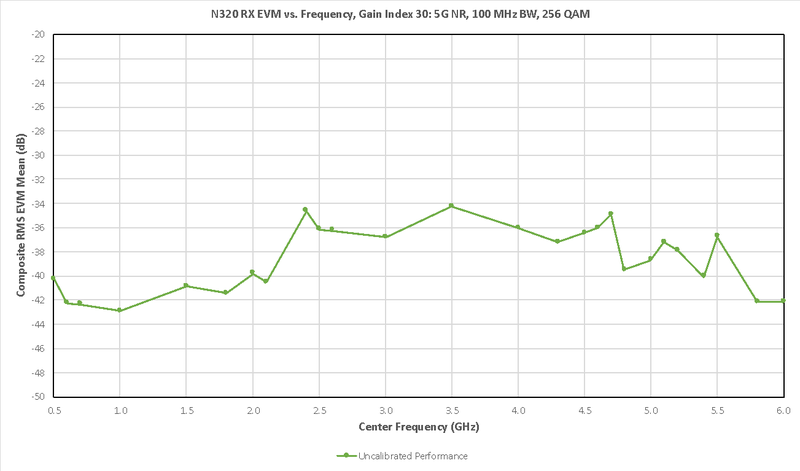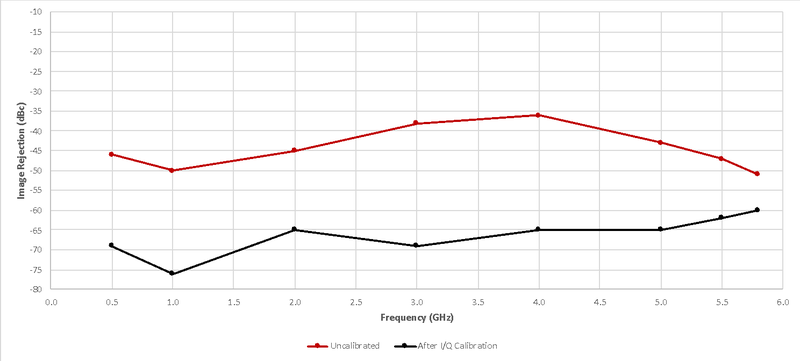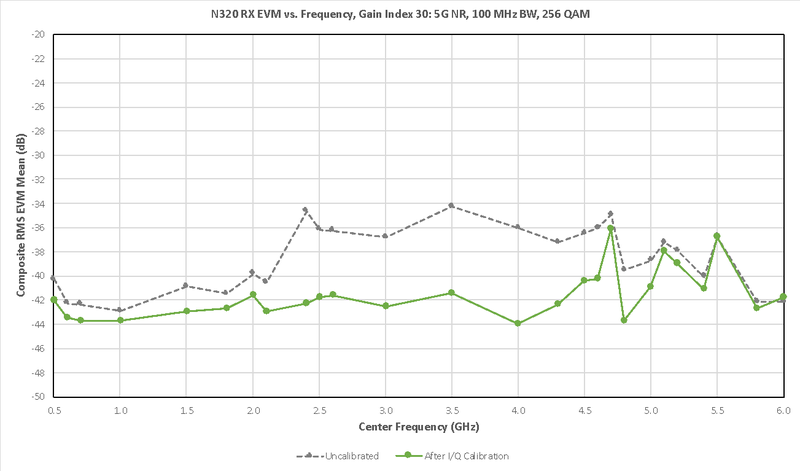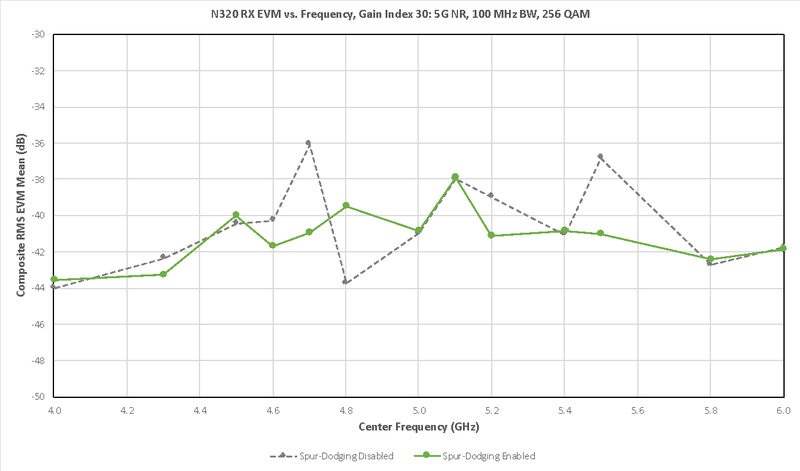Difference between revisions of "5G NR EVM Measurements with the USRP N320/N321"
(Created page with "== Application Note Number == '''AN-452''' == Revision History == {| class="wikitable" !Date !Author !Details |- |style="text-align:center;"| 2019-04-17 |style="text-align:...") |
|||
| (One intermediate revision by the same user not shown) | |||
| Line 12: | Line 12: | ||
|style="text-align:center;"| Initial creation | |style="text-align:center;"| Initial creation | ||
|} | |} | ||
| − | |||
| − | |||
== Abstract == | == Abstract == | ||
| Line 24: | Line 22: | ||
The gain index of the USRP N320/N321 receiver was fixed at 30 dB and the carrier frequency was swept from 500 MHz to 6 GHz. The modulated waveform was acquired and analyzed to compute the EVM. The corresponding results are shown in the following plot: | The gain index of the USRP N320/N321 receiver was fixed at 30 dB and the carrier frequency was swept from 500 MHz to 6 GHz. The modulated waveform was acquired and analyzed to compute the EVM. The corresponding results are shown in the following plot: | ||
| − | [[File:evm_fig_1.png| | + | [[File:evm_fig_1.png|800px|center]] |
== I/Q Image Calibration == | == I/Q Image Calibration == | ||
| Line 42: | Line 40: | ||
The image level was measured using external equipment before and after calibration to show the improvement, as shown in the plot below: | The image level was measured using external equipment before and after calibration to show the improvement, as shown in the plot below: | ||
| − | [[File:evm_fig_2.png| | + | [[File:evm_fig_2.png|800px|center]] |
The EVM versus frequency was measured once again after applying the RX I/Q calibration. Significant improvements can be observed as demonstrated in the following comparison plot: | The EVM versus frequency was measured once again after applying the RX I/Q calibration. Significant improvements can be observed as demonstrated in the following comparison plot: | ||
| − | [[File:evm_fig_3.png| | + | [[File:evm_fig_3.png|800px|center]] |
== Spur-Dodging Mode == | == Spur-Dodging Mode == | ||
| Line 56: | Line 54: | ||
During the original measurement above, a few frequencies exhibited spur levels high enough to degrade the EVM performance. These frequencies were remeasured after enabling the spur-dodging algorithm. The corresponding EVM performance improved at these frequencies as highlighted in the following plot: | During the original measurement above, a few frequencies exhibited spur levels high enough to degrade the EVM performance. These frequencies were remeasured after enabling the spur-dodging algorithm. The corresponding EVM performance improved at these frequencies as highlighted in the following plot: | ||
| − | [[File:evm_fig_4.png| | + | [[File:evm_fig_4.png|800px|center]] |
== Conclusions == | == Conclusions == | ||
Latest revision as of 14:36, 17 April 2019
Contents
[hide]Application Note Number
AN-452
Revision History
| Date | Author | Details |
|---|---|---|
| 2019-04-17 | Drew Fischer | Initial creation |
Abstract
Example EVM measurements are shown using the USRP N320/N321 receiver and the 5G New Radio (5G NR) modulation standard. The use of I/Q image calibration and spur-dodging are demonstrated as methods to improve EVM performance.
Measurement Description
The NI-RFmx NR software [ http://sine.ni.com/nips/cds/view/p/lang/en/nid/217188 ] and the PXIe-5840 Vector Signal Transceiver [ http://www.ni.com/en-us/support/model.pxie-5840.html ] were used to continuously generate a waveform using the 5G NR modulation standard. The waveform was configured for 100-MHz bandwidth, 256 QAM, and DFTS OFDM. The modulated signal generated by the Vector Signal Transceiver was connected to the RX2 input of the USRP N320/N321. Additional test code was written to acquire and post-process the received waveform in order to calculate EVM.
Raw Performance
The gain index of the USRP N320/N321 receiver was fixed at 30 dB and the carrier frequency was swept from 500 MHz to 6 GHz. The modulated waveform was acquired and analyzed to compute the EVM. The corresponding results are shown in the following plot:
I/Q Image Calibration
One key contributor to EVM performance is the image level. Images are generated by the I/Q demodulator in the signal chain and are an artifact of this receiver architecture. The image level can be measured and accounted for using the I/Q image calibration utility available in UHD, as shown in the example below.
From directory:
~/src/uhddev/host/build/utils
For CH0, run:
sudo ./uhd_cal_rx_iq_balance --subdev A:0 --freq_start 0.5e9 --freq_stop 6e9 --freq_step 0.1e9 --verbose
For CH1, run:
sudo ./uhd_cal_rx_iq_balance --subdev B:0 --freq_start 0.5e9 --freq_stop 6e9 --freq_step 0.1e9 --verbose
The image level was measured using external equipment before and after calibration to show the improvement, as shown in the plot below:
The EVM versus frequency was measured once again after applying the RX I/Q calibration. Significant improvements can be observed as demonstrated in the following comparison plot:
Spur-Dodging Mode
At some frequencies, synthesis spurs can be higher than desired and can result in EVM degradation. A spur-dodging algorithm was implemented for the USRP N320/N321 to improve the spurious performance when desired. By default, the spur-dodging algorithm is disabled, but can be enabled by adding the following device argument:
--args “spur_dodging=enabled”
During the original measurement above, a few frequencies exhibited spur levels high enough to degrade the EVM performance. These frequencies were remeasured after enabling the spur-dodging algorithm. The corresponding EVM performance improved at these frequencies as highlighted in the following plot:
Conclusions
The USRP N320/N321 receiver with the 5G NR modulation standard exhibits excellent EVM performance. This performance can be further improved by taking advantage of the RX I/Q calibration utility available in UHD as well as the spur-dodging algorithm unique to the USRP N320/N321.
Footnotes The EVM performance presented here was measured on a single unit at room temperature during product development. The performance demonstrated here is for informational purposes only and is not covered by warranty.




